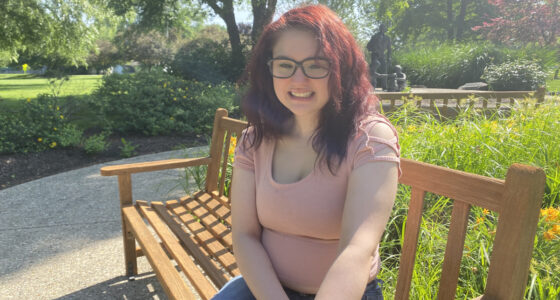
Pediatric scoliosis occurs when a child’s spine curves in different directions as they grow. The condition can often be treated and monitored throughout childhood. If the curve is severe or gets worse, there are pediatric scoliosis treatment options such as bracing, casting or surgery. It is important to identify the condition early to stop the curvature from getting worse and preventing pain.
View Child-Friendly ExplanationIf you have scoliosis, it doesn’t mean you are sick. It just means you might need to have some help – like a growing tree – to straighten out your backbone as you grow taller.
Pediatric Orthopedic doctor
What is Scoliosis
What is Scoliosis
Scoliosis is a common condition that involves a sideways curve in the spine of 10 degrees or more. A sign of scoliosis includes a noticeable hump when a child bends forward. If left untreated, it can often cause pain, stiffness, or limited range of motion.
For children, there are three types of scoliosis conditions:
- Adolescent idiopathic scoliosis. The most common type of scoliosis often develops during the rapid growth of puberty. This type of scoliosis is more common in girls.
- Congenital scoliosis. A type of scoliosis that is present at birth where the bones do not form normally.
- Neuromuscular scoliosis. A form of scoliosis that is caused by a neuromuscular condition or disorder, such as spina bifida or cerebral palsy, where a child’s nervous system and muscles have been affected.
Symptoms of Scoliosis in Kids & Teens
Symptoms of Scoliosis in Kids & Teens
Doctors do not know what causes scoliosis in childhood, but we do know that it is not inherited or passed down from our parents. It is most often developed when children are growing and going through puberty. Scoliosis is more common in girls than boys.
Common symptoms of scoliosis include:
- Uneven shoulders
- Uneven hips
- Visible curve in spine
- Prominent rib cage
Patients often wonder if scoliosis can cause pain. Pain is sometimes a symptom of scoliosis, but it doesn’t always happen. Pain from scoliosis is typically more common in adults than children. However, children with very severe forms of scoliosis can also experience pressure as the curvature adds pressure to the surrounding muscles and nerves.
If you suspect your child may have scoliosis, consult your pediatrician or family doctor.
How is Scoliosis Diagnosed
How is Scoliosis Diagnosed
Scoliosis screening is a normal part of physical exams during your child’s annual visit to the pediatrician or family doctor. Screening ages are different based on gender, but it typically happens around the end of elementary school for girls and during middle school for boys. Early intervention can help stop spine curvatures from getting worse and can sometimes improve the curvature.
During a scoliosis screening, your child’s doctor will begin with a simple “forward bend test” to check the spine. The patient will bend forward, and if one side of the body lifts higher than the other, it may indicate a deformity or curve in the spine. If a forward bend test reveals a spine curvature, your child’s doctor may follow up with an x-ray to view the entire spine. These images help the doctor determine the size or severity of the curvature. Curves of 10 degrees or more are considered scoliosis.
Severity types include:
- Mild. Young patients with mild curves are monitored to see if the degree of the curve gets worse as they grow. Further treatment may not be needed.
- Moderate. Children with a 20 to 40-degree curve have moderate scoliosis. As the child may still be growing, a back brace can support the spine to prevent the curve from getting worse or needing surgery in the future.
- Severe. If the curve is greater than 45 to 50 degrees, the scoliosis is considered severe. Though less common, this scoliosis requires spine surgery because it can get worse quick. If left untreated, the condition can limit lung function or cause other complications in the body.
How is Scoliosis Treated
How is Scoliosis Treated
There are different pediatric scoliosis treatment options depending on the child’s age and degree of the curve.
For smaller curves, treatment may include:
- Observation. A physician will monitor the spine to ensure the curvature does not get worse.
- Physical Therapy. This can improve a child’s core strength and flexibility. The Schroth Method of physical therapy is specifically designed for scoliosis correction.
- Bracing. Back braces are a plastic shell that hold the spine in place. It sits underneath a child’s clothing and is commonly worn for 18 to 20 hours a day. It is the most common treatment for children with scoliosis.
- Casting. A treatment for infants and smaller children ages one to four. Casts are made of plaster and help keep the spine in place to stop the curve from getting worse until the child is old enough for a brace or surgery. Casts are worn 24/7.
For more severe cases, scoliosis surgery is recommended to ensure the spine is in the proper position, while also allowing the child to continue growing.
Surgical treatment options include:
- Spinal fusion. This is the most common type of surgery used to treat scoliosis. In this procedure, spine surgeons fuse the spine together. Children must wait until they’re mostly done growing to undergo spinal fusion surgery.
- Growing rods. Rods are surgically placed in a child’s spine to help support the curvature. As the child grows into the rod, it is expanded every few months.
- Non-fusion surgery. A treatment, also known as “tethering,” that places screws in the spine to pull into alignment. This procedure heavily relies on the child’s future growth.
Key Points to Remember
Key Points to Remember
- Pediatric scoliosis is a condition that causes a curve in a child’s spine. It is most common among girls or adolescent children who are growing.
- It is important to diagnose scoliosis early and monitor it frequently, so the curve doesn’t get worse.
- A sign of scoliosis involves a noticeable sideways curve when a child bends forward.
- There are multiple treatment options depending on the child’s age and the severity of the curve.
Support Services & Resources
Support Services & Resources
We offer a broad range of supportive services to make life better for families who choose us for their children's care.
Locations
Locations
Locations
In addition to our primary hospital location at the Academic Health Center in Indianapolis, IN, we have convenient locations to better serve our communities throughout the state.
Sort through 65 facilities offering Scoliosis care by entering your city or zip below.
Departments Treating This Condition
Departments Treating This Condition
Related Stories
Related Stories

Ortho, pain teams work to get patient moving again
From wheelchair to walking independently, Mooresville girl credits her doctors for giving her a chance for a better life.
Continue reading
Specialized PT can freeze scoliosis in its place
Riley offers advanced therapy for some adolescent scoliosis patients that may help them avoid surgery.
Continue reading





